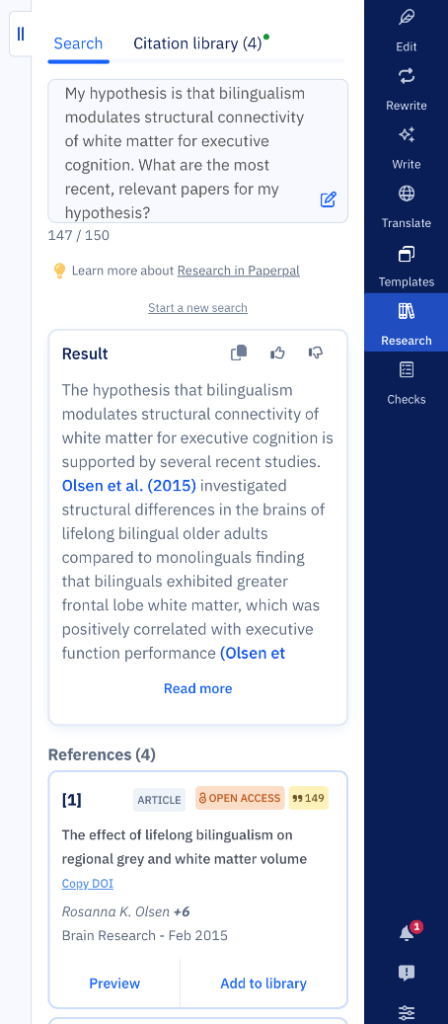The National Institutes of Health (NIH)—a major federal funding agency for scientific research—reported a 20% success rate1 for funding of new research projects in 2022. That is, only one in 10 applicants who submitted grant applications from across the globe received monetary support from the NIH to conduct their research.
As a researcher, grappling with the tedious and intensive process of grant writing and making these numbers work in your favor is crucial to your career, no matter where you are in your trajectory of climbing up the academic ladder.
Let’s put things in perspective first—what is it about grant applications that makes them so elusive to begin with, and what strategies and best practices can you align with to put your best foot forward in writing a grant? To answer these questions, it is imperative to understand what reviewers look for in grant applications and where most of these applications falter.
Table of Contents
- Grant Writing: What Reviewers Look for in Research Funding Applications
- 3 Practical Grant Writing Tips to Elevate Your Grant Applications
- How to Write Strong Grant Applications with Paperpal
Grant Writing: What Reviewers Look for in Research Funding Applications
According to grant reviewers at the National Institute of Allergy and Infectious Diseases (NIAID),2 many applicants fall short in failing to support their hypotheses and discussing contingency plans in case their original approach does not work, while others are weak in making a case for why the studies are being done in the first place. Although a number of factors contribute to whether your application makes the cut or not, in essence, reviewers place irrevocable emphasis on the scientific merit of the grant application when making research funding decisions. This can be preliminarily judged on the following criteria:
- Influence in the field of research: If the project’s aims are achieved, how would the current scientific knowledge and capability advance and further drive the field forward?
- Challenging the status quo: Does the proposed research seek to move the needle on the currently accepted concepts and approaches?
- Well-reasoned approach: Is the project founded on strategies that ensure an unbiased inquiry, with a sound understanding of potential challenges, alternatives, and benchmarks/milestones of the project?
Although not an exhaustive list, these factors are foundational to what makes a well-rounded grant application with higher chances of being favorably reviewed. A case in point is this publicly available grant application by Dr. David Wagner, a recognized voice in the field of autoimmune research, particularly type 1 diabetes.3 The grant reviewers lauded the applicant for setting a strong premise for the proposed study based on reliable published data, rigor of the experimental approach, and backing the application with promising preliminary results.
3 Practical Grant Writing Tips to Elevate Your Grant Applications
Creating the perfect grant application and navigating the grant writing process can be daunting. You need to do your research and get science-backed insights to support your proposal. Here are some go-to tips to polish your grant application and put your best foot forward:
Align well with the grant requirements
Read the submission criteria and driving principles of the grant organization thoroughly and ensure that you highlight how your proposal befits them. What may seem to be a simple housekeeping step can go a long way to convince reviewers that you have done the due diligence of tailoring your grant application to the requirements and expectations of the funding body.
Pin down the ‘so what’ of your proposal
While drafting your grant application, focus on why you want to investigate the aims that you identify and why the outcome of your research would be of importance in a larger and broader context. Developing a sharp elevator pitch can help you get closer to a convincing answer of the ‘so what’ of your proposal.
Get your grant application critiqued
A thorough critique early on in the grant writing journey by friends, colleagues, or professional grant reviewers/editing services is critical. This can help you break out of your thought patterns and biases and reflect on your proposal from multiple facets and perspectives. The diversity and depth that this exercise can bring to your proposal would be a great value addition in the favor of your grant application.
How to Write Strong Grant Applications with Paperpal
The art of competitive grant writing involves writing about facts and ideas with intrigue and from a broader point of view, something that may not be second nature to an academic who is already juggling with a desk load of tasks from troubleshooting experiments, drafting rebuttals for their manuscripts’ peer reviews, and attending to administrative duties.
With Paperpal as your academic writing guide, you can create a compelling narrative for your grant application. A well-rounded understanding of scientific literature is crucial in backing and validating your ideas that are still to be put to the test in a laboratory. With Paperpal’s ‘Research’ feature, you can get answers to specific research enquiries from a repository of over 250 million research publications. Using these inputs, you can back up your hypothesis with relevant findings. This would give you a good footing to set a strong premise for your grant application.

Here’s a quick 3-step process to leverage Paperpal’s Research feature effectively:
1. Submit your query: Login or sign-up to Paperpal for free and click on the Research tab. Type your question in simple English to get instant factual insights from over 250 million articles, with verified sources.
2. Review and save: Scan the summarized response and citations provided by the AI; click to read related references and save relevant papers to your citation library.
3. Cite references: Use these insights to develop your grant writing; don’t forget to cite relevant references to deliver a well-thought-out grant application for research funding.
Paperpal transforms how you research and write, turning a typically long, disjointed process into a seamless experience. Try Paperpal for free today to back your ideas with evidence and nail the grant writing game!
References:
- Lauer, M. FY 2022 By the Numbers: Extramural Grant Investments in Research. National Institutes of Health, March 2023. Available online at https://nexus.od.nih.gov/all/2023/03/01/fy-2022-by-the-numbers-extramural-grant-investments-in-research/
- Mohan-Ram, V. Murder Most Foul: How Not to Kill a Grant Application. Science, January 2000. Available online at https://www.science.org/content/article/murder-most-foul-how-not-kill-grant-application
- Wagner, D.H. Developing a small peptide to control autoimmune inflammation in type 1 diabetes. Available online at https://www.niaid.nih.gov/sites/default/files/R41-Wagner-Summary-Statement.pdf
Paperpal is a comprehensive AI writing toolkit that helps students and researchers achieve 2x the writing in half the time. It leverages 21+ years of STM experience and insights from millions of research articles to provide in-depth academic writing, language editing, and submission readiness support to help you write better, faster.
Get accurate academic translations, rewriting support, grammar checks, vocabulary suggestions, and generative AI assistance that delivers human precision at machine speed. Try for free or upgrade to Paperpal Prime starting at US$19 a month to access premium features, including consistency, plagiarism, and 30+ submission readiness checks to help you succeed.
Experience the future of academic writing – Sign up to Paperpal and start writing for free!



